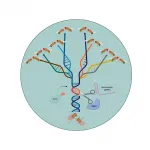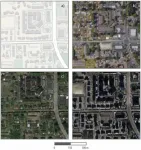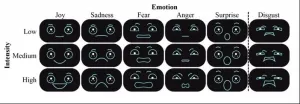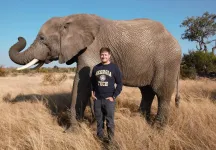(Press-News.org) DALLAS, June 2, 2021 -- A "prescription" to sit less and move more is the optimal first treatment choice for reducing mild to moderately elevated blood pressure and blood cholesterol in otherwise healthy adults, according to the new American Heart Association scientific statement published today in the American Heart Association's journal Hypertension.
"The current American Heart Association guidelines for diagnosing high blood pressure and cholesterol recognize that otherwise healthy individuals with mildly or moderately elevated levels of these cardiovascular risk factors should actively attempt to reduce these risks. The first treatment strategy for many of these patients should be healthy lifestyle changes beginning with increasing physical activity," said Bethany Barone Gibbs, Ph.D., FAHA, chair of the statement writing group and associate professor in the department of health and human development and clinical and translational sciences at the University of Pittsburgh in Pittsburgh, Pennsylvania.
An estimated 21% of U.S. adults, about 53 million, have systolic (top number) blood pressure between 120-139 mm Hg or diastolic (bottom number) blood pressure between 80-89 mm Hg; both values are abnormally high. Individuals in this range who have an otherwise low risk of heart disease or stroke meet the American College of Cardiology (ACC)/American Heart Association (AHA) High Blood Pressure Guideline criteria for lifestyle-only treatment for elevated blood pressure.
Likewise, the scientific statement authors estimate that 28% of U.S. adults, or about 71 million, have an LDL cholesterol score above 70 mg/dL and otherwise meet criteria for low risk of heart disease or stroke. These people would meet the 2018 AHA/ACC Cholesterol Treatment Guidelines criteria for lifestyle-only treatment. Lifestyle changes highlighted in the blood pressure and cholesterol guidelines include increased physical activity, weight loss, improving diet, stopping smoking and moderating alcohol intake.
"Increasing physical activity can help lower blood pressure and cholesterol, along with many other health benefits." Gibbs said. Physical activity also has benefits beyond cardiovascular health, including a decreased risk of some cancers, improved bone, brain and mental health, and better sleep.
Increasing physical activity results in clinically meaningful reductions in systolic and diastolic blood pressure, typically an average reduction of 3 or 4 mm Hg. Similar improvements are seen with blood cholesterol. For example, increased physical activity typically decreases LDL cholesterol by 3 to 6 mg/dL.
The statement highlights research concluding that physically active people have a 21% lower risk of developing cardiovascular disease and a 36% lower risk of death from cardiovascular diseases compared to those who are not physically active.
To improve health, the U.S. Department of Health and Human Services 2018 Physical Activity Guidelines for Americans suggest individuals participate in either a cumulative 150 minutes of moderate intensity aerobic exercise, or 75 minutes of vigorous aerobic activity weekly plus two or more strength training sessions each week.
However, there is no minimum amount of time to receive benefits from physical activity. "Every little bit of activity is better than none," said Gibbs. "Even small initial increases of 5 to 10 minutes a day can yield health benefits."
The statement provides suggestions for clinicians to provide exercise "prescriptions" such as patient counselling, incorporating health behavior professionals (e.g., health coaches) and connecting patients to local resources like community centers to help meet their physical activity needs.
According to the statement, prescribing exercise includes:
Screening patients about physical activity at every interaction, as recommended by the American College of Sports Medicine's 'Exercise is Medicine' campaign. Clinicians can ask patients to report their physical activity with a few questions or by using a wearable device.
Providing ideas and resources for supporting patients to improve and sustain regular physical activity;
Meeting patients where they are by exploring activities that the patient enjoys and provide ideas for early success; and
Encouraging and celebrating small increases in physical activity, such as walking more or taking the stairs.
"In our world where physical activity is increasingly engineered out of our lives and the overwhelming default is to sit - and even more so now as the nation and the world is practicing quarantine and isolation to reduce the spread of coronavirus - the message that we must be relentless in our pursuit to 'sit less and move more' throughout the day is more important than ever," said Gibbs.
INFORMATION:
This scientific statement was prepared by the volunteer writing group on behalf of the American Heart Association's Council on Lifestyle and Cardiometabolic Health; the Council on Cardiovascular and Stroke Nursing; and the Council on Clinical Cardiology.
Co-authors and members of the volunteer writing group are Felipe Lobelo, M.D., Ph.D., FAHA, vice chair; Marie-France Hivert, M.D., M.M.Sc.; Gerald J. Jerome, Ph.D., FAHA; William E. Kraus, M.D., FAHA; Sara Rosenkranz, Ph.D.; Erica N. Schorr, Ph.D., R.N.; and Nicole Spartano, Ph.D. Author disclosures are in the manuscript.
Additional Resources:
Available multimedia is on right column of release link - https://newsroom.heart.org/news/prescription-to-sit-less-move-more-advised-for-mildly-high-blood-pressure-cholesterol?preview=ea44dc5eabb5b6b1a872d0a0260b8cb4
After June 2, view the manuscript online.
Commentary by Linda S. Pescatello, Ph.D.
Fit in walking morning, noon or night
Staying motivated for fitness
Follow AHA/ASA news on Twitter @HeartNews
The Association receives funding primarily from individuals. Foundations and corporations (including pharmaceutical, device manufacturers and other companies) also make donations and fund specific Association programs and events. The Association has strict policies to prevent these relationships from influencing the science content. Revenues from pharmaceutical and biotech companies, device manufacturers and health insurance providers are available here, and the Association's overall financial information is available here.
About the American Heart Association
The American Heart Association is a relentless force for a world of longer, healthier lives. We are dedicated to ensuring equitable health in all communities. Through collaboration with numerous organizations, and powered by millions of volunteers, we fund innovative research, advocate for the public's health and share lifesaving resources. The Dallas-based organization has been a leading source of health information for nearly a century. Connect with us on heart.org, Facebook, Twitter or by calling 1-800-AHA-USA1.
A large group of iconic fossils widely believed to shed light on the origins of many of Earth's animals and the communities they lived in may be hiding a secret.
Scientists, led by two from the University of Portsmouth, UK, are the first to model how exceptionally well preserved fossils that record the largest and most intense burst of evolution ever seen could have been moved by mudflows.
The finding, published in Communications Earth & Environment, offers a cautionary note on how palaeontologists build a picture from the remains of the creatures they study.
Until now, it has been widely accepted the fossils buried in mudflows in the Burgess Shale in Canada that show the result of the Cambrian ...
CRISPR-based technologies offer enormous potential to benefit human health and safety, from disease eradication to fortified food supplies. As one example, CRISPR-based gene drives, which are engineered to spread specific traits through targeted populations, are being developed to stop the transmission of devastating diseases such as malaria and dengue fever.
But many scientists and ethicists have raised concerns over the unchecked spread of gene drives. Once deployed in the wild, how can scientists prevent gene drives from uncontrollably spreading across populations ...
CHICAGO -- Women who experience acute aortic dissection--a spontaneous and catastrophic tear in one of the body's main arteries--not only are older and have more advanced disease than men when they seek medical care, but they also are more likely to die, according to research published online today in The Annals of Thoracic Surgery.
"Data over the course of the last few decades demonstrate differences in both presentation and outcomes between males and females who have acute aortic dissection, with greater mortality among females," said Thomas G. Gleason, MD, from Brigham and Women's Hospital in Boston, Massachusetts. "This study underscores ...
Can you trust the map on your smartphone, or the satellite image on your computer screen?
So far, yes, but it may only be a matter of time until the growing problem of "deep fakes" converges with geographical information science (GIS). Researchers such as Associate Professor of Geography Chengbin Deng are doing what they can to get ahead of the problem.
Deng and four colleagues -- Bo Zhao and Yifan Sun at the University of Washington, and Shaozeng Zhang and Chunxue Xu at Oregon State University -- co-authored a recent article in Cartography and Geographic Information Science that explores the problem. In "Deep ...
Popcorn. What would movies and sporting events without this salty, buttery snack? America's love for this snack goes beyond these events. We consume 15 billion quarts of popped popcorn each year.
When it comes to popcorn, consumers want a seed-to-snack treat that leaves more snacks than seeds when popped. This means when they pop the corn, there shouldn't be many unpopped kernels left in the bowl.
Maria Fernanda Maioli set out to determine the properties affecting popping expansion in popcorn. The team's research was recently published in Agronomy Journal, a publication of the American Society of Agronomy.
"The way kernels expand is a basic, ...
BEER-SHEVA, Israel...June 2, 2021 - As drones become more ubiquitous in public spaces, researchers at Ben-Gurion University of the Negev (BGU) have conducted the first studies examining how people respond to various emotional facial expressions depicted on a drone, with the goal of fostering greater social acceptance of these flying robots.
The research, which was presented recently at the virtual ACM Conference on Human Factors in Computing Systems, reveals how people react to common facial expressions superimposed on drones.
"There is a lack of research on how drones are perceived and understood by humans, which is vastly different than ground robots." says Prof. Jessica Cauchard together with Viviane Herdel of BGU's Magic Lab, in the BGU Department of Industrial ...
New research from the Georgia Institute of Technology finds that elephants dilate their nostrils in order to create more space in their trunks, allowing them to store up to nine liters of water. They can also suck up three liters per second -- a speed 50 times faster than a human sneeze (150 meters per second/330 mph).
The Georgia Tech College of Engineering study sought to better understand the physics of how elephants use their trunks to move and manipulate air, water, food and other objects. They also sought to learn if the mechanics could inspire the creation of more efficient robots that use air motion to hold and move things.
While octopus use jets of water to move and archer fish shoot water above the surface to catch insects, the Georgia Tech researchers found that elephants ...
Boulder, Colo., USA: Article topics include Zealandia, Earth's newly recognized continent; the topography of Scandinavia; an interfacial energy penalty; major disruptions in North Atlantic circulation; the Great Bahama Bank; Pityusa Patera, Mars; the end-Permian extinction; and Tongariro and Ruapehu volcanoes, New Zealand. These Geology articles are online at https://geology.geoscienceworld.org/content/early/recent.
Mass balance controls on sediment scour and bedrock erosion in waterfall plunge pools
Joel S. Scheingross; Michael P. Lamb
Abstract: Waterfall plunge pools experience cycles of sediment aggradation and scour that modulate ...
CHAPEL HILL, NC - Research published by JAMA Network Open shows how non-pharmaceutical interventions (NPIs) like mask wearing and physical distancing can help prevent spikes in COVID-19 cases as populations continue to get vaccinated. The study, led by Mehul Patel, PhD, a clinical and population health researcher in the department of Emergency Medicine at the UNC School of Medicine, focuses on the state of North Carolina. Similar modeling studies have been used in different states, and can serve as guidance to leaders as they make decisions to relax restrictions and safety protocols.
"The computer simulation modeling allows us to look at multiple factors that play a role in decreasing the spread of COVID-19 as vaccines are ...
PROVIDENCE, R.I. [Brown University] -- By delivering small electrical pulses directly to the brain, deep brain stimulation (DBS) can ease tremors associated with Parkinson's disease or help relieve chronic pain. The technique works well for many patients, but researchers would like to make DBS devices that are a little smarter by adding the capability to sense activity in the brain and adapt stimulation accordingly.
Now, a new algorithm developed by Brown University bioengineers could be an important step toward such adaptive DBS. The algorithm removes a key hurdle that makes it difficult for DBS systems to sense brain signals while simultaneously delivering stimulation.
"We know that there are electrical signals ...






